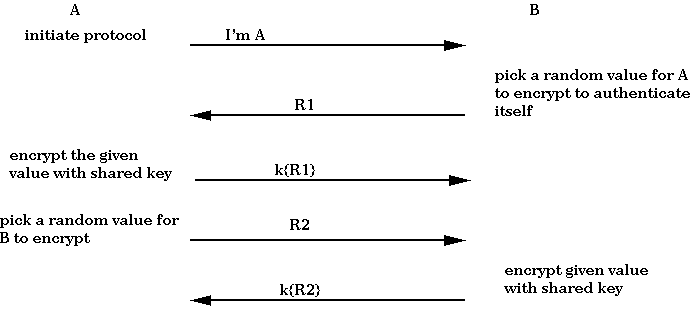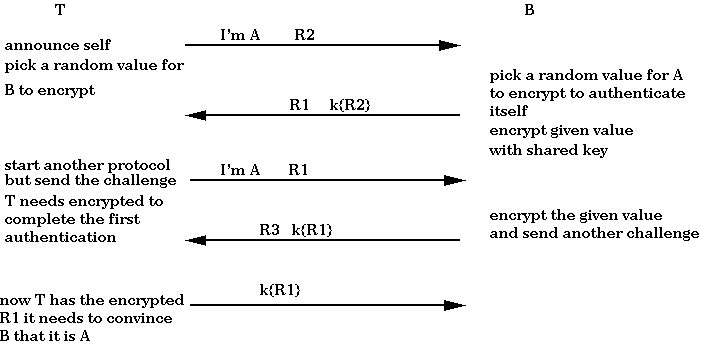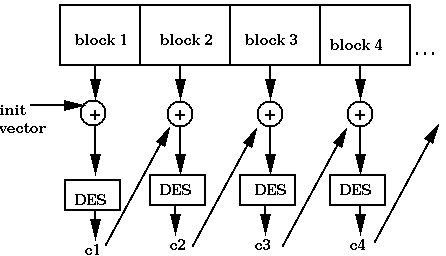Secret Key Cryptography & DES
Lecturer: Professor Fred B. Schneider
Lecture notes by
Lynette I. Millett
Last time we discussed several primitive cryptosystems. We mentioned two
properties, confusion and diffusion, that are desirable in any
cryptosystem.
There are three
classes of cryptographic functions that turn out to be useful:
- secret key -- one key, referred to as the secret key; we saw examples
of this last time,
- public key -- two keys, referred to as private and public keys,
- hash -- zero keys.
Secret Key Cryptography
Secret key cryptography involves two functions:
- encryption: E(key, message) -> enciphered text
- decryption: D(key, ciphertext) -> message.
These functions are inverses of each other, so that message
= D(key, E(key, message)). The E and D notation is a bit verbose, so we
will use the notation k{m} to say that
message m was encrypted under key k.
Uses for secret key cryptography include: transmitting secret
messages in the presence of passive eavesdroppers, storing information
in encrypted form on insecure media, and authentication (determining
who is involved in a given dialogue.) Note: if you are using
encryption to store data on insecure media, most editors work on a
decrypted form of data. Thus, they may store temporary unencrypted
versions of your data.
Authentication, as we have seen it before, is often done with a
password. However, that form of authentication involves revealing the
'secret' (password) in order to prove one's identity. We are
interested in strong authentication--providing proof of
identity without revealing the secret. In other words, strong
authentication involves proving knowledge of a secret (key/password)
without revealing the secret itself.
Suppose we would like user A to prove to user B that A is A
without revealing the secret that is the essence of being A, and vice
versa. Thus, we desire a protocol that allows A and B to authenticate
themselves to each other. Assume that there is a shared, secret key:
k. Knowing k is proof of being either A or B. The desired mutual
authentication protocol works as outlined below. The arrows indicate
sending a message.
 There are many subtle errors that can arise when designing
cryptographic protocols. We now illustrate some. First, note in the
above protocol that B sends A two messages in a row. An obvious
optimization might be to combine those messages into one, as well as
having A announce itself and send a random bit string for B to encrypt
at the same time.
There are many subtle errors that can arise when designing
cryptographic protocols. We now illustrate some. First, note in the
above protocol that B sends A two messages in a row. An obvious
optimization might be to combine those messages into one, as well as
having A announce itself and send a random bit string for B to encrypt
at the same time.
 This protocol, however, if flawed. In particular, it is susceptible to
what is known as a reflection attack. It is possible for an
eavesdropper, T, to convince B that T is A. T exploits the fact that B
seems willing to encrypt challenges. Therefore, T can pretend to be A
as follows:
This protocol, however, if flawed. In particular, it is susceptible to
what is known as a reflection attack. It is possible for an
eavesdropper, T, to convince B that T is A. T exploits the fact that B
seems willing to encrypt challenges. Therefore, T can pretend to be A
as follows:
 After B sends R1 to T, T needs to get it encrypted under k in order
to convince B that T is A. T therefore starts another session, sending
R1 which B then returns encrypted. T now learns the encrypted
version of R1 and can convince B that B is communicating with A.
After B sends R1 to T, T needs to get it encrypted under k in order
to convince B that T is A. T therefore starts another session, sending
R1 which B then returns encrypted. T now learns the encrypted
version of R1 and can convince B that B is communicating with A.
There are several possible approaches to repairing the protocol:
- Use two different keys, one from A to B and another from B to A. This
introduces additional keys to keep track of.
- Insist that the challenge from the initiator look different from the
challenge from the responder. If this holds, then T can never get B to
encrypt the 'right thing.' For instance, suppose A generates random even
numbers and B generates random odd numbers. Then B would never encrypt a
random number that it had generated (as in the above example.)
- Initiator must prove its identity first. This is based on the assumption
that the initiator in a protocol is likely to be the attacker (if anyone
is). In the above examples, B would respond with a challenge of its own
before responding to A's (T's) challenge. The reflection attack in this
type of protocol would not work.
Industrial-Strength Cipher: DES
Data Encryption Standard (DES) is an example of an industrial-strength
encryption algorithm. The mathematics of why this results in a good
cipher is beyond the scope of this course. However, we will discuss
some details of how it works. DES is based on the IBM "Lucifer"
algorithm of 1974 and became a U.S. standard in 1976. Having an
encryption standard is useful, because it makes interactions possible
that might otherwise need to be customized. The downside, of course,
is the uncertainty as to whether there are agencies that can break the
standard.
DES takes in 64 bits of data, a 56-bit key and executes 16 cycles of
substitution and permutation before outputting 64 bits of data.
 Is a 56-bit key long enough? This depends. Suppose you have a 50 MIP CPU. It
can handle
300 kilobytes/second if DES is implemented in software. Due to expected
increases in processor price/performance, it is necessary to add 1 bit to the
key every 2 years to preserve this level of work for cracking DES. In
1993, Weinen at Bell Northern Research proposed a DES cracking machine.
It uses a chip that costs $10.50 to manufacture and can try 50 million DES
keys per second. Thus,
Is a 56-bit key long enough? This depends. Suppose you have a 50 MIP CPU. It
can handle
300 kilobytes/second if DES is implemented in software. Due to expected
increases in processor price/performance, it is necessary to add 1 bit to the
key every 2 years to preserve this level of work for cracking DES. In
1993, Weinen at Bell Northern Research proposed a DES cracking machine.
It uses a chip that costs $10.50 to manufacture and can try 50 million DES
keys per second. Thus,
- $1 million buys a parallel machine that can try all DES keys in 7 hours,
- a $10 million parallel machine can try all DES keys in 21 minutes, and
- a $100 million parallel machine can try all the keys in two minutes.
Note that DES encrypts only 64 bits at a time. How are long messages
encrypted? There are two modes available that we will discuss:
Electronic Code Book (ECB) and Cipher Block Chaining (CBC).
In ECB mode, a message is broken into 64 bit blocks and each block
is encrypted separately. One problem with this approach is that if two
blocks are identical, then they will be identically encrypted. Another
problem is that a substitution attack is now possible. Rather than
reading a message, an attacker can change the meaning of a message by
snipping out pieces of the text and replacing them with encrypted
versions of another message.
In CBC mode, "random" bits are added to each block based on the
previous block. Specifically, each block is encrypted separately using
not only the key but a random bit string as well. This bit string
becomes part of the key material. The first block is XORed with an
initialization vector. The result is then encrypted by DES as
usual. This becomes the first ciphertext block. Also, this block is
XORed with the second block, and then the result is encrypted by DES
to become the second ciphertext block. The process continues as
illustrated in the following diagram.
 It is best to use a random initialization vector (even though it must
then be included somewhere in the message). One could just use a
vector of 0s as the initialization vector, but then an eavesdropper
could detect identical prefixes of messages. CBC has very high
diffusion, since the information from one block is spread through the
successive blocks. It is also immune from the substitution attack
described above. One negative aspect of CBC is that a single bit error
propagates throughout multiple blocks and can render the entire
message undecipherable.
It is best to use a random initialization vector (even though it must
then be included somewhere in the message). One could just use a
vector of 0s as the initialization vector, but then an eavesdropper
could detect identical prefixes of messages. CBC has very high
diffusion, since the information from one block is spread through the
successive blocks. It is also immune from the substitution attack
described above. One negative aspect of CBC is that a single bit error
propagates throughout multiple blocks and can render the entire
message undecipherable.





